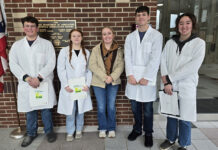“When, what to my wondering eyes should appear, but a miniature sleigh and eight tiny reindeer. With a little old driver, so lively and quick, I knew in a moment it must be St. Nick.”
“…And then, in a twinkling, I heard on the roof, the prancing and pawing of each little hoof. As I drew in my hand, and was turning around, down the chimney St. Nicholas came with a bound.”
Wait a minute! When Clement Clark Moore wrote this stanza, did he ever question how that friendly crew of home-invaders got up on the roof in the first place or when, exactly, they developed this criminalistic scheme?
Maybe it’s time for this retired wildlife officer to do some investigating.
First, we need to review what we know about this legendary delivery service. They were first reported by Moore in his 1820 poem, “A Visit from St. Nicholas.” In it, he described how St. Nick (aka Santa Claus) used his reindeer team of accomplices to assist in his unannounced entries to allegedly leave gifts for good girls and boys. Moore’s work is best known as “The Night Before Christmas.”
It’s interesting that Moore first reported the incident anonymously, which gives pause as to the veracity of his claim. Was it to avoid self-incrimination, prior knowledge or personal involvement? Was he unsure what neighbors might think of his declarations or was he just a concerned citizen attempting to keep the world honest?
Moore later relented, admitting that he wrote the well-penned report during a snowy sleigh-ride. I could find no evidence that schnapps, bourbon or other spirits were involved, neither intoxicant nor those produced by Dickens.
Apparently, Moore had spotted a local Dutch handyman which inspired the account. Allegedly, the man reminded him of the historical figure Saint Nicholas. Saint Nick was unsurprisingly fervent about his religious beliefs and was dedicated to the protection of innocent children, but he has never been directly implicated.
When pressed, Moore admits that a close friend may have helped to shape his narrative. This influencer was found to be a Mr. Washington Irving.
Moore’s insistence that reindeer pulled St. Nick’s sleigh was discovered to be well-founded and historically accurate in many areas where the animals are native residents. Their ability to cover long distances with little rest makes them valuable drafting animals for pulling both wagons and sleds.
Reindeer are also used to provide meat, though there’s absolutely no evidence that any person named Santa, Santa Clause or Saint Nick have ever considered roasting reindeer burgers. While there appears to be a number of height-challenged persons involved in various supporting roles, their primary foods seem to consist of sugar cookies and cocoa.
So far, Mr. Moore’s story remained plausible but there persists a need for corroborating evidence to lend it more credence. Enter witness Robert Lewis May’s authentication. According to May’s unsworn testimony, transcribed in 1939, he describes the experiences of Rudolph, a youthful reindeer buck who possesses a luminous red nose.
The young deer was mocked by his peers and excluded from participation in amusing pastimes. May asserts that Rudolph proved himself one foggy Christmas Eve. Due to poor visibility and upcoming storms, the evening’s rooftop deliveries were about to be canceled. May maintains that Santa arrived at the scene and said, “Rudolph, with your nose so bright, won’t you guide my sleigh tonight?”
It remains unclear if May witnessed the statement or asks us to take this account on faith. Nevertheless, Rudolph apparently agreed to Santa’s terms and is later favored by his fellow reindeer for his heroism. The reindeer team became devoted teachers, instructing future sleigh pullers of this historical occurrence.
Montgomery Ward Department Store capitalized on Rudolph’s exploits by using the situation in a marketing ploy. Some conspiracy theorists tried to link the shining nose to the military establishment but such suspicions are unfounded.
Remaining is the question of exactly how these reindeer are becoming airborne or if this is the Achilles’ heel of the whole Santa Claus-Saint Nick story. Surprisingly, my investigation has uncovered evidence that may support May and Moore’s narratives.
There have been accounts showing that as reindeer move about foraging for food, they sometimes consume hallucinogenic mushrooms. Ancient Finnish Sami shamans would drink the urine of the animals and would suffer hallucinations during which they would see the reindeer floating about in space. This hypothesis does have its challengers.
“Mushrooms have been used to a certain extent in shamanic ceremonies,” said Arja Jomppanen, a researcher at Sida, the National Museum of the Finnish Sami in Inari. “But drinking urine has not been mentioned in accounts of Sami traditions.”
Hakan Rydving, an expert in Sami religion at Norway’s University of Bergen, rejects the theory as a myth. “There is no such information at all from the Sami world, neither about drinking the urine of reindeer, nor of seeing flying reindeer in their dreams,” he said.
While both seem to discredit the theory, neither expert appeared anxious to take a sip to verify a negative report. While I’m not certain if ingestion of hallucinogenic mushrooms is required by either Shaman or reindeer to cause flight, I do remember a landmark birthday party in which I swear I personally witnessed a golden retriever levitating over a campfire. Due to that rather foggy experience, I’ll allow some leeway for evidence indicating airborne deer.
You know Dasher and Dancer and Prancer and Vixen, Comet and Cupid and Donner and Blitzen, but Robert Lewis May asks us to recall the most famous reindeer of all. That would be the aforementioned Rudolph, whom he definitely described as a male buck deer. So, are the rest of Santa’s gang all males? The evidence is mixed.
“Santa’s reindeer are really females,” said Alice Blue-McLendon, a Texas A&M veterinary professor specializing in deer. The presence of antlers is her primary evidence. She explains that reindeer grow antlers regardless of gender, and that males typically shed them before Christmas while females retain them into March. Therefore, the team is female.
Greg Finstad manages the Reindeer Research Program at the University of Alaska, and he disagrees, saying that Santa’s sleigh-pullers are castrated males, known as steers. He concedes that bulls shed antlers before Christmas, but that steers carry them through March as do the expectant mothers who retain their antlers until spring calving. This allows females to protect food sources for developing fetuses.
A good herdsman knows that bulls are too tired after their polygamous mating season and that many females are then pregnant. Therefore, Finstad insists that the sledder’s best pulling choice are the well-conditioned steers that skipped the rut.
We must assume that Mr. Claus is likely an expert herdsman and sledder. Besides, Finstad has geography on his side since he has the North Pole near his hometown venue. Living in such close proximity, it is even possible that Finstad may be concealing knowledge of Claus’ capers. Neither expert commented on reindeer urine, hallucinogens, floating golden retrievers or how any of them learned to fly.
I must note that during this investigation, evidence surfaced of a copycat intruder which plagued one small town. He was described as wearing a poor imitation of a Santa suit and had coerced a canine for sled duties. His motive appears to have been envy which affected his general pallor.
While his initial exploits were of a sinister nature, many witnesses came forward; one “Who” stated that the suspect had self-rehabilitated and was once again a cherished member of the community.
Finally, we must consider how Santa Claus differentiates between good girls and boys. This brings us back to Clement Clark Moore. In his work Old Santeclaus, he indicates some apparently inside information about Saint Nick’s deciding qualifications.
“The steady friend of virtuous youth, the friend of duty, and of truth, each Christmas eve he joys to come, where love and peace have made their home.”
The evidence is in and I find it conclusive. Christmas remains alive and well within the human spirit and in the world around us. Santa’s job — our job — is to be reminded of the importance of the season and how just one day is never enough.
As for myself, I believe. “Happy Christmas to all, and to all a good-night.”
Then the Grinch thought of something he hadn’t before!
‘Maybe Christmas,’ he thought, ‘doesn’t come from a store.’
‘Maybe Christmas … perhaps … means a little bit more!’
And what happened then? Well … in Whoville they say,
That the Grinch’s small heart grew three sizes that day!
— Dr. Seuss














Bravo Jim! As to the flying reindeer, may I refer you to a song by Jim Stafford called the “Wildwood Weed”? The two brothers flew up on the windmill. Maybe more to this than you think. Merry Christmas!